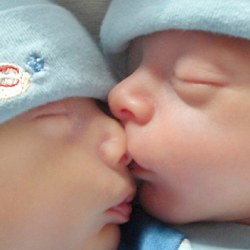A multiple pregnancy is a pregnancy with two or more babies. In some multiple pregnancies, the babies develop from different eggs (fraternal); in others, they develop from the same egg (identical). When the babies are fraternal, each has a separate placenta (whose fetal part is called the chorion) and separate amniotic sacs. These are known as dichorionic-diamniotic twins. The babies may be boys, girls, or a combination of both. Like siblings born from different pregnancies, these babies may (or may not) look very similar to each other. Depending on when the fertilized egg splits, identical twins may also be dichorionic-diamniotic. Usually, however, the babies share a placenta and have separate sacs. These are known as monochorionic-diamniotic twins. About 75 percent of all identical twins fall into this category. In rare cases, identical babies share both a single placenta and a single amniotic sac. These are known as monochorionic-monoamniotic twins. Because all identical babies share the same genetic material, they will be of the same gender and look alike, although they will have different personalities.


